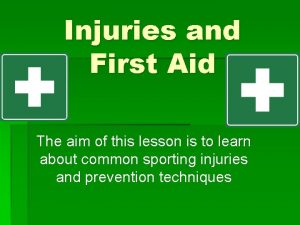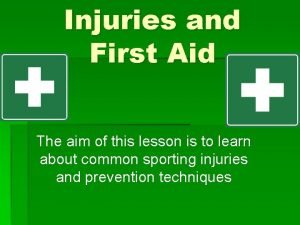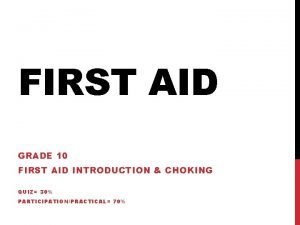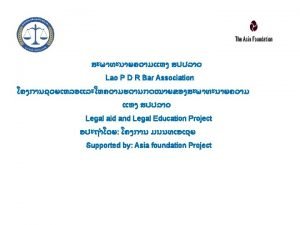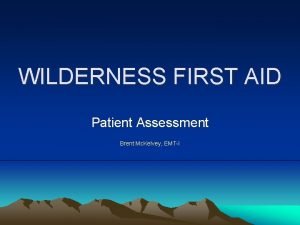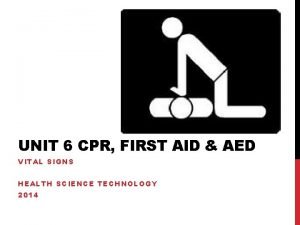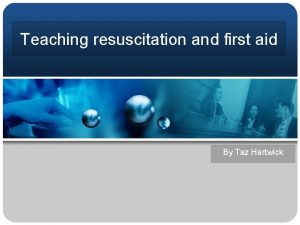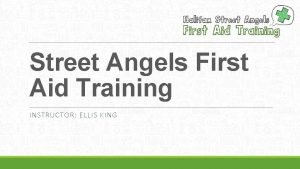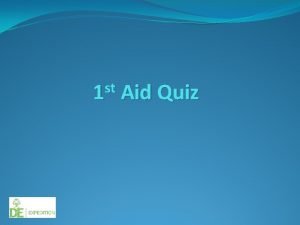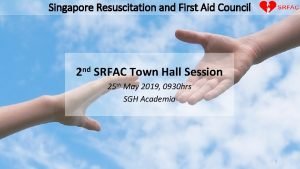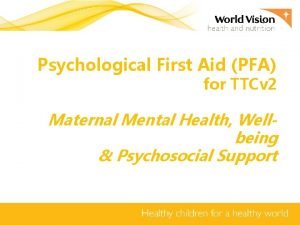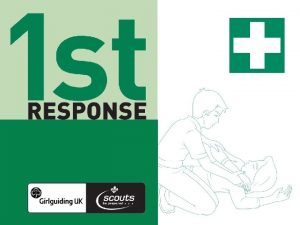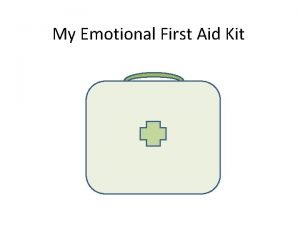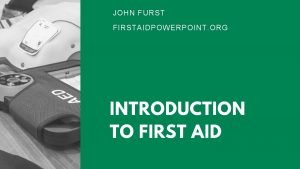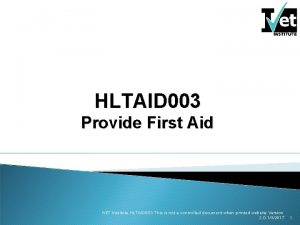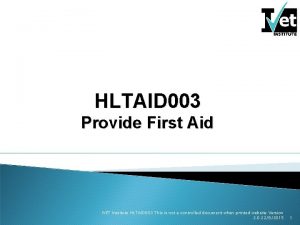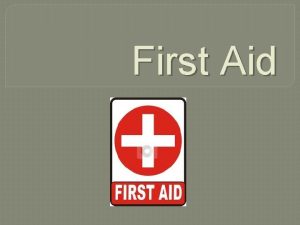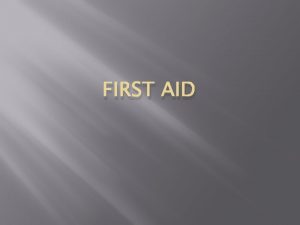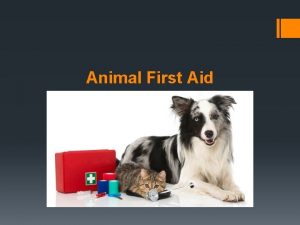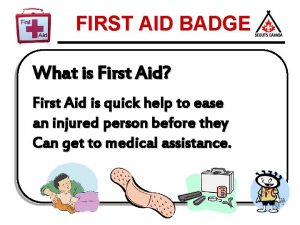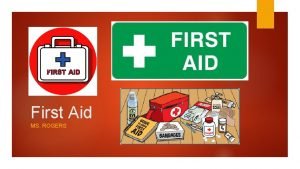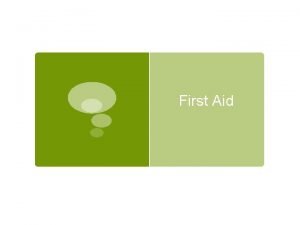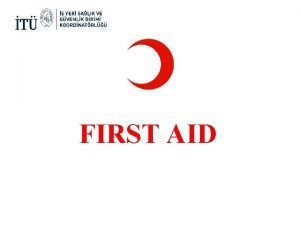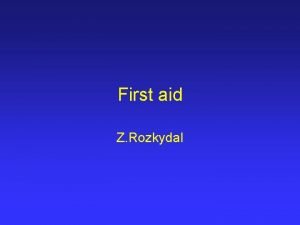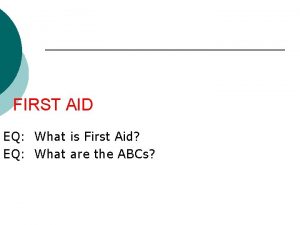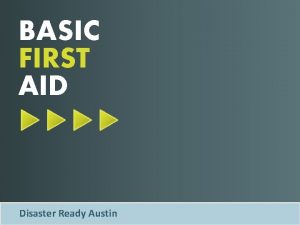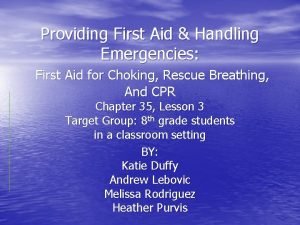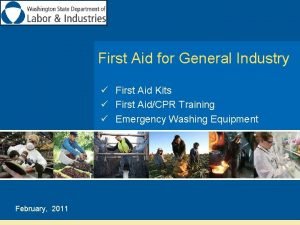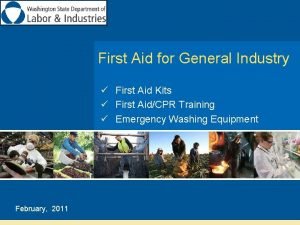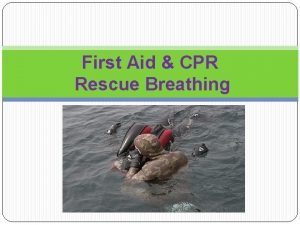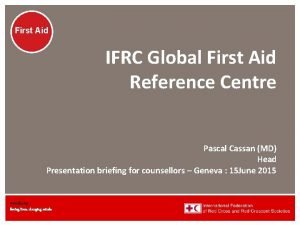First Aid The aim of this lesson is




























- Slides: 28

First Aid The aim of this lesson is to learn about common sporting injuries and prevention techniques

Asish K. Das Sports Physio-c. Conditioning Trainer

Physical Fitness Is The Key TO PREVENT INJURIES IN DAILY LIFE

Two Types of Sports Injury § Acute Injuries: are the result of a sudden stress on the body. For example, a dislocated shoulder caused by a tackle in rugby. § Chronic or Overuse Injuries: are caused by over training, insufficient recover time, poor technique and badly designed footwear or equipment.

How to Avoid Chronic Injuries § Develop correct technique: Poor long distance running technique leads to back injuries. § Choose kit and equipment carefully, especially footwear. § Allow enough time for full recovery between training sessions and/or events.

Sports Injury

How to Avoid Chronic Injuries § Develop correct technique: Poor long distance running technique leads to back injuries. § Choose kit and equipment carefully, especially footwear. § Allow enough time for full recovery between training sessions and/or events. • Follow heavy training days with light days. As your body adapts to training it recovers, if you don’t recover you’ll gain no training adaptation.

How to Avoid Acute Injuries § Consider the event itself: § Make sure you play at the right level for you. It can be dangerous to play against people who are bigger, stronger or more skilful. • Know the rules of the sport and obey them. They were developed to protect you as well as test your skill. 1. Pay attention to advice or warnings given by coaches, referees and other officials.

HEAD INJURIES § You should place the person in the coma position making sure they can breathe easily – check nose and mouth for blockages – if they are not breathing you will need to follow CPR.

Bone and Joint Injuries Signs and Symptoms: § A fracture is a break or § The casualty may have heard or felt a snap. crack in a bone. In a § Pain and tenderness SIMPLE or CLOSED around the injury. fracture the skin is not broken. In an OPEN or § The casualty cant move COMPOUND fracture the part normally. the skin is damaged too. § Swelling and bruising occur. § The limb may look deformed and twisted. Fractured bones:

§ A stress fracture is a thin crack in a bone, which can be caused by overuse and continuous stress to the bone. These are common in the legs of runners and soldiers. Stress fractures are the only form of chronic bone injury, all other fractures are acute § NO EVIDENCE IN X-RAY

SOFT TISSUE INJURIES § Soft tissue is basically anything that isn't bone! So muscles, ligaments, tendons, skin, cartilage etc. Soft tissue injuries can be either chronic or acute. They can also be open or closed § Open injuries are when the skin is broken through cuts, grazes etc § Closed injuries happen when the skin stays intact, and the injury is underneath the skin. § EXAMPLES § Sprains - ligament damage. Ligaments attach bones to bones and keep a joint together. Sprains can occur as a result of a violent twisting or side-ways movement to the joint (such as when you roll the ankle over and sprain it)

SOFT TISSUE INJURIES (CONT) § Strains - muscle damage. These are also known as pulled muscles and can vary in severity with some only causing minor damage and other tearing the whole muscle (a rupture)! These are usually caused by overstretching. The hamstrings are the most common example § Bruising - bleeding underneath the skin. This usually happens as a result of an impact such as being hit with a cricket ball

SOFT TISSUE INJURIES (CONT) § Dislocations - a bone is pulled away from the normal joint position. The most common example is the shoulder, where the humerus (arm bone) is pulled out of the socket. This can cause damage to the surrounding soft tissues and must be scanned with an MRI before being repositioned

§ Cartilage tears cartilage within the knee is most commonly injured. This happens through violent twisting or impacts which force the knee out of line § LIGAMENT § PARTIAL TEAR § TORN § PHYSIOTHERAPY OR SURGURY ? SOFT TISSUE

9830467038

R. I. C. E. TREATMENT § Standard treatment for soft tissue injuries is R - REST The first 24 -48 hours after the injury is considered a critical treatment period and activities need to be curtailed. Gradually use the injured extremity as much as tolerated, by try to avoid any activities that cause pain. Often using a splint, sling, or crutches is necessary to adequately rest the injured body part.

RICE TREATMENT §I - ICE Icing an injured body part is an important part of treatment. Icing injuries can be effective for sprains, strains, overuse injuries and bruises. Learn how to properly ice your injury. § Get the ice on quickly. Icing is most effective in the immediate period following an injury. The effect of icing diminishes significantly after about 48 hours.

RICE TREATMENT § Perform an "ice massage. " Apply ice directly to the injury. Move the ice frequently, not allowing it to sit in one spot. § Don't forget to elevate. Keep the injured body part elevated above the heart while icing -- this will further help reduce swelling.

ICE § Watch the clock. Ice for 15 -20 minutes, but never longer. You can cause further damage to the tissues, including frostbite, by icing for too long. § Allow time between treatments. Allow area to warm for at least 45 minutes or an hour before beginning the icing routine again. § Repeat as desired. Ice as frequently as you wish, so long as the area is warm to touch and has normal sensation before repeating.

§ C - Compression: Use compression when elevating a sprain or strain in early treatment. Using an Ace bandage, wrap the area overlapping the elastic wrap by one-half of the width of the wrap. The wrap should be snug, but not cutting off circulation to the extremity. So, if your fingers or toes become cold, blue, or tingle, re-wrap! § E - Elevate: Keep your sprain or strain as best possible--try to get it higher than your heart if possible. Elevate at night by placing pillows under your arm or leg.

GENERAL RULES TO FOLLOW § AMBULATION § GLOVES § PHONE § 2 nd line CO-ORDINATOR § PRACTICE – MAHARA § COMMANDER IN CHIEF

PREVENTIVE EXERCISES TAPING

PREVENTIVE EXERCISES TAPING SWISS BALL STABILITY

PREVENTIVE EXERCISES TAPING Balance Training

PREVENTIVE EXERCISES

PREVENTIVE EXERCISES

HAPPY COACHING
 First aid merit badge first aid kit
First aid merit badge first aid kit First aid aim
First aid aim The aim of first aid is to
The aim of first aid is to Which is an objective of first aid
Which is an objective of first aid Legal aid meaning aim and objective
Legal aid meaning aim and objective Neasden and greenhill medical centre
Neasden and greenhill medical centre Aim of the lesson
Aim of the lesson First aid patient assessment form
First aid patient assessment form Raf cadet badge placement
Raf cadet badge placement 6 vital signs first aid
6 vital signs first aid Unit 15:1 providing first aid
Unit 15:1 providing first aid Coyne first aid
Coyne first aid Taz hartwick
Taz hartwick First aid angels
First aid angels First aid quiz for students
First aid quiz for students Srfac
Srfac First aid for slips and falls in the kitchen
First aid for slips and falls in the kitchen Camping merit badge powerpoint
Camping merit badge powerpoint Psychological first aid
Psychological first aid Preserve life first aid
Preserve life first aid First aid for caregivers
First aid for caregivers Emotional first aid kit ideas
Emotional first aid kit ideas Three ps in first aid
Three ps in first aid Quotes about first aid
Quotes about first aid Injuries first aid
Injuries first aid Ivet first aid
Ivet first aid Hltaid
Hltaid Seabase first aid kit
Seabase first aid kit Rice first aid
Rice first aid

